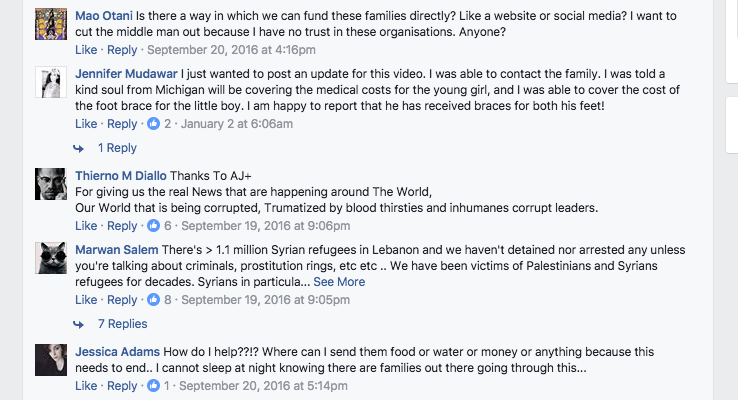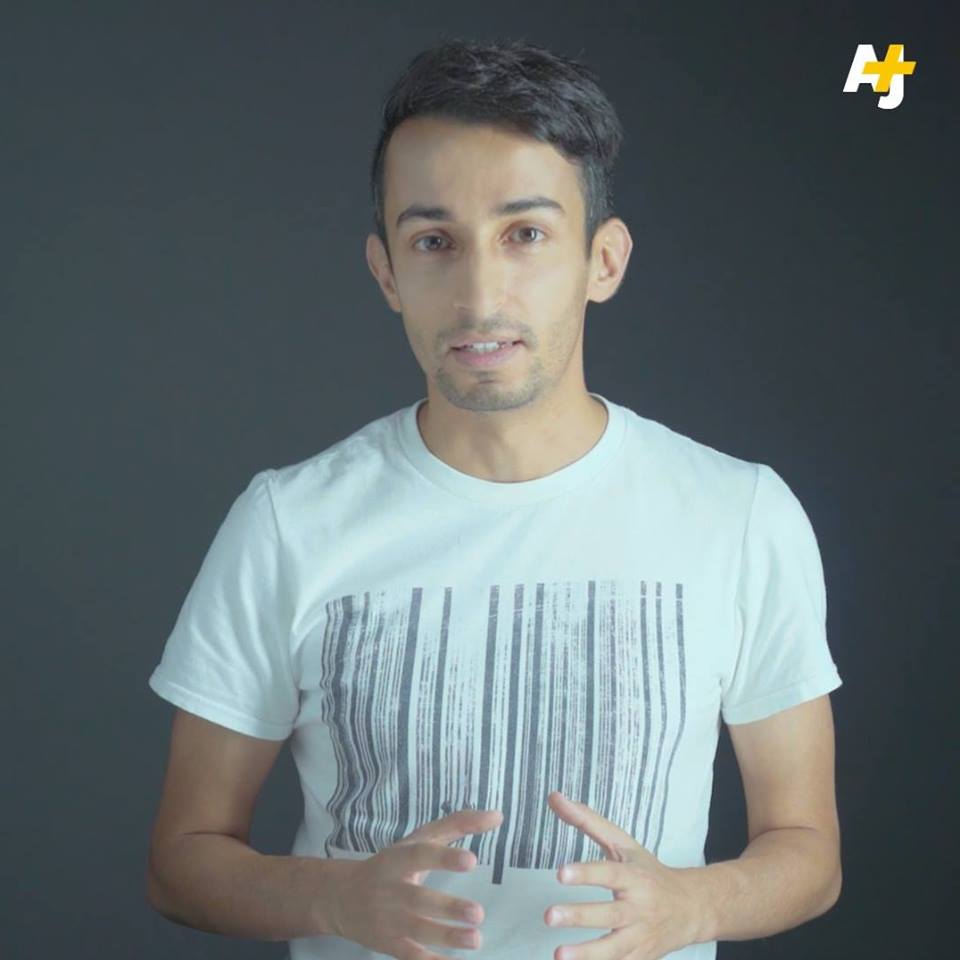The horrific scenes became more accessible than ever before. Audiences have access to raw footage from activists and uncensored videos as soon as journalists do, sometimes even before. The openness of reporters – even old-school print and broadcast journalists who engage with their audience on Twitter – has allowed viewers to go behind the scenes. They are with us through the news cycle now, instead of just tuning into a finished package on the evening news bulletin.
Watch AJ+ and you will notice how things look very different about the way we cover conflict. AJ+ is not just reaching new audiences on new platforms, it is changing the way they tell stories. Social news along with a more media-literate audience has allowed us – forced us – to reinvent the way we cover war and conflict. Audiences demand that we do not sanitise our coverage. Our stories are pushed onto people’s news feeds: They come to our audience, not vice versa. Viewers are not making an active choice to sit down and watch the evening news bulletin – they come across us as they scroll on Facebook, or as their Twitter feed updates. This has implications for how we do things.
So, what does this mean? It means we have to be aware that putting shocking footage at the top of a video may not be appropriate. We need to prepare our audience for what they are about to see, either with a warning bumper or through the language of our storytelling. Our audience does not appreciate a gratuitous video that does not tell the story of a bigger social issue. When we are showing graphic footage, we need to do it for a reason. Sometimes we get it wrong, and our audience is quick to let us know.
The Feedback Loop
Social news has its own unique dimension. This has to do with what we call the feedback loop and the idea of “engagement”. At AJ+, the moment we post a story is just the beginning of our news cycle, while many television news journalists finish their job as soon as their package airs. There is no instant interaction between broadcast reporters and the audience – at least not in the same way.
Often, our audience knows more about the story than we do. As soon as a video goes up, they start fact-checking – if there are any errors, they will comment within minutes. That is the scariest moment for producers. It also imposes a much higher burden of fact-checking on us than traditional broadcast media. The comments section is directly below our work, and it allows our audience to discuss, critique, and crowdsource the facts. Unlike television news, our coverage does not just flow one way, our videos are the start of a conversation.
The comments section is also a useful way to source stories or to move stories forward. For example, we did a story about babies born with heroin addiction (because the mother was addicted) and the moral issues that it raises. In the comments section, victims of this condition joined the conversation. They were able to interact with our audience, answer questions and, in effect, do a follow-up Q&A for people who had just watched our video. We commissioned one of the commenters to write about her experiences (1).

Screenshot of an article written by Destiny Kruse about her drug addiction recovery and motherhood experiences
When we did a story about a Syrian refugee family living illegally in Lebanon with two disabled kids who needed treatment, we had hundreds of offers of help. People were commenting under the video offering cash, medical equipment, and even visa sponsorship. These potential donors connected with NGOs in the comments section by email and succeeded in helping this family.

Screenshot of the comment section of the AJ+ video: “Syrian Refugees: Living Illegally”
Screen grab of the fundraising campaign started by Team Mohammed surpassed the $15,000 goal
We also covered the story of a Syrian refugee child who has progeria – a condition that makes him age prematurely. He looks like an old man in a child’s body. Within two months, the video had been watched by 21 million people. One of those was the man set to be the UK’s first Muslim astronaut. He flew to Turkey to meet seven-year-old Mohammed, and we covered the emotional meeting where he handed over gifts and put a smile on the young boy’s face. Also, a group of women from the United States were moved to help Mohammed after viewing our video. A 10-person fundraising team grew to more than 100 supporters. They started a campaign to help Mohammed’s family to start their asylum process, so he can live in a country that can provide him with the healthcare and education that he needs. (2)
Safety and Ethics
When covering war and conflict, outsourcing all of the risks and responsibilities saves money. It is less costly to hire a freelancer than sending your own staff to the field. But these kinds of decisions come with great responsibilities. Protecting staff and freelancers should be the top priority for broadcasters and publishers.
The death of a freelance photographer who had taken pictures for Reuters in Aleppo in 2013 was a lesson for us all. It was a reminder that we should not be chasing the story at any cost. (3)
At AJ+, most of our original material comes from freelance journalists. This raises a few issues: When freelance journalists pitch us, they may not have been through hostile environment training or be covered by our insurance.
But there is a bigger issue here – Al Jazeera is one of the world’s biggest broadcasters, so even if we could protect ourselves and our freelancers, we could create a dangerous market. We are very careful about where we commission from – we do not hire freelancers in certain regions. The reason? If it becomes known that we are taking freelance material from, for example, Syria, that might encourage inexperienced journalists to try their luck, go in, and then pitch us. Take as an example the case of Sunil Patel, a 25-year-old who went to Syria to learn how to become a journalist and was very lucky to survive.(4) His story shows how certain regions can become a magnet for young journalists. It is also a reminder of how the risks of covering war can be magnified by a lack of preparation, backing from a media organisation, insurance and training.
So, what is the answer? While we cannot go into places like Syria, and while I do not believe we should commission from some places, we can still cover these stories effectively. We should never rely solely on activist networks. We should always develop our own verification and double-sourcing standards to fact-check the content they produce, or use verified UGC footage from news agencies. We have a responsibility not to treat activists as free employees. We should not ask them to shoot footage for us just because they are in the right place at the right time. What we can do is to combine activist footage with Skype interviews that we do from the newsroom. We interview people on the ground by Skype and then cut it and edit it into our final video in the same way that traditional media would use a field interview.
Does this cut corners? I do not believe it does. The same fact checking, verification and due diligence that we do with freelance journalists, should also be applied to video material coming from war zones. Of course, activists have an editorial line that they want to push, but we never take any video at face value.
We need to keep our colleagues safe – whether they are staff or freelance – without missing the story. The way that journalism is changing, where journalists are building new relationships with our audiences who are not just viewers but also contributors, means that we do not need to miss the story.
How to Commission Safely
When you are commissioning in a conflict zone, do not let your freelance contributor take any risks that you would not allow a staff member to. There are a few important things to check:
-
Has the freelancer got insurance to report from a conflict zone? If not, will your company insurance cover them? Do you need to inform your insurer? Insurance is mandatory for freelancers working for you from war zones.
-
Has the freelancer had conflict zone training? If not, can you sponsor them to get training before working with them? The Rory Peck Trust is a great resource for freelance journalists.(5)
-
Is the freelancer legally allowed to work in the country? Even if they are not at risk from the belligerent parties, they might get in trouble if they are on a tourist visa – and that may endanger other freelancers, or even your own staff in that country.
-
Do you have a bureau in that country, or a country specialist in your newsroom? Are there any country-specific dangers that you or your freelancer need to be aware of? Have you informed your bureau that you are commissioning a freelancer in their country? (If he/she gets in trouble, the first door the authorities knock on will be your bureau’s. Also, the freelance journalist will not only feel safer if being backed by your local bureau but can also contact them to ask for help if needed).
-
Is the freelancer working with a local fixer? If not, why not? Do you know and trust any fixers in the area?
-
Is the deadline and fee that you are paying reasonable and fair? A low fee or an unnecessarily tight deadline could encourage the freelancer to take risks and cut corners.
War zones have become the most dangerous places in the world to carry out the act of journalism. But we have a duty to continue telling war stories to our audiences. The tragedy in Syria has become a graveyard for journalists. But it should not become a graveyard for journalism.
This article first appeared as a chapter in the book "Journalism in Times of War"
References:
-
Kruse, Destiny. “My journey from heroin addiction to motherhood.” Medium, December 11, 2015. https://medium.com/aj-story-behind-the-story/my-submission-for-aj-1bfc5cb3da1a
-
Team Mohammed. “When social media isn’t all bad.” Medium, January 31, 2017. https://medium.com/aj-perspectives/when-social-media-isnt-all-bad-5fd3bc62e0d7
-
Reuters. “Syrian photographer killed in Aleppo.” Reuters, December 21, 2013. http://www.reuters.com/article/us-syria-crisis-photographer-idUSBRE9BK09T20131221
-
Patel, Sunil. “I Went to Syria to Learn How to Be a Journalist.” Vice, November 13, 2013. https://www.vice.com/sv/article/i-went-to-syria-to-learn-how-to-be-a-journalist
-
Rory Peck Trust: www.rorypecktrust.org







































